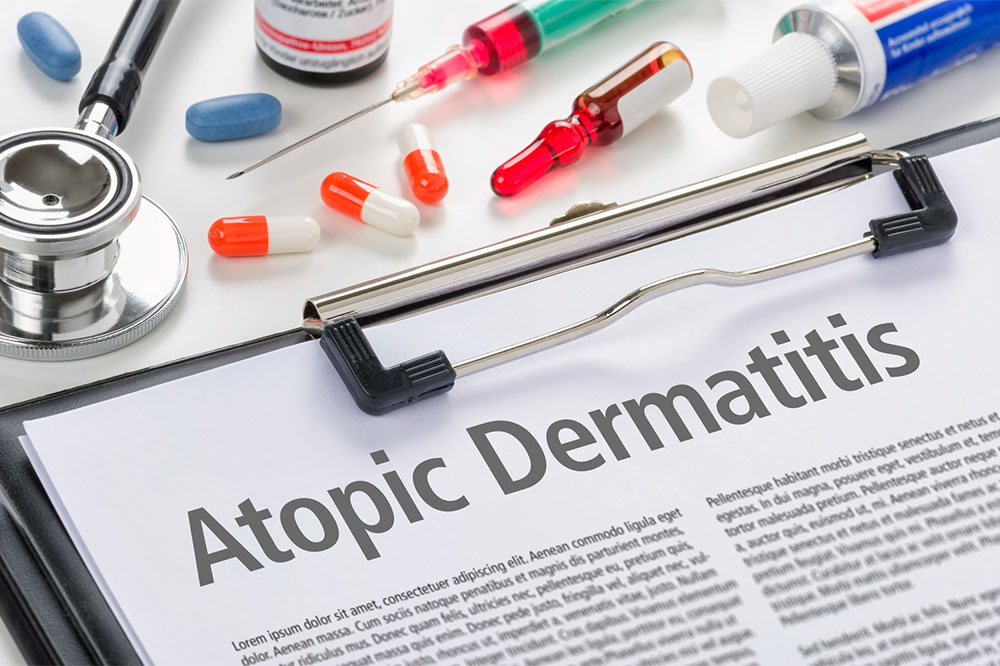
4 effective ways to manage atopic dermatitis
Atopic dermatitis (eczema) is a skin condition that causes the skin to appear dry, red, and itchy. This condition can affect infants, children, and adults. Although it does not cause any major harm, loss of the skin barrier due to dermatitis can increase the chances of the skin becoming dry and prone to infections. Here are some essential tips on treatment plans, food options, and healthy lifestyle choices to help manage atopic dermatitis:
Treatment for atopic dermatitis
Eczema is a group of skin illnesses that results in inflamed skin. Atopic dermatitis is known to be the most common type. According to dermatologists, there is no permanent cure for the condition. A person with this skin disorder might need to try various treatments over a long period of time to reduce the symptoms. The following is a list of major treatment options used to manage the skin condition and its symptoms.
DUPIXENT ®
DUPIXENT® is a commonly used treatment option to relieve allergic diseases such as asthma, nasal polyps, and eczema. This FDA-approved option helps in reducing the symptoms of moderate-to-severe atopic dermatitis. DUPIXENT® is generally used for patients who are 12 years and older. It is a subcutaneous injection that needs to be administered under supervision. The dosage is based on multiple factors, including the patient’s age and the condition being treated.
CIBINQO™
It is another prescribed treatment used for adults with moderate-to-severe atopic dermatitis. It is commonly used in combination with other topical treatment options. CIBINQO™ can be taken orally, once a day, or as recommended by a physician. The treatment method works by blocking the JAK 1 protein, and this process is expected to reduce inflammation and its flare-ups. The dosage depends on the severity of the condition.
Upadacitinib
Upadacitinib (brand name RINVOQ ™ ) is most commonly used for the treatment of rheumatoid arthritis as well as atopic dermatitis. RINVOQ ™, approved by the FDA, is used for treating moderate-to-severe atopic dermatitis in those aged 12 and older. This treatment option is considered when it is difficult to control eczema with other methods. It is recommended to avoid its use with other JAK inhibitors.
Eucrisa
Eucrisa (risaborole) can be used to treat mild to moderate atopic dermatitis in children and adults. It has been in use for over a decade. This non-steroidal treatment option is applied as an ointment twice a day, and it works both above and under the skin to control eczema symptoms. It is for topical use, and avoid its application on the mouth and eye areas.
Manage your meal plans
One of the major causes of atopic dermatitis can be your daily food habits. The direct relationship between food allergies and eczema is unknown. However, allergies caused due to certain food may trigger eczema. Foods that can cause such allergic reactions such as eczema are milk and milk products, peanuts, sugar, eggs, gluten, fish, shellfish, rice, and sesame oil. Following a healthy balanced meal plan can be vital in dealing with skin diseases. Including foods that have anti-inflammatory properties like apples, blueberries, spinach, cherries, kale, fatty fish, and probiotic foods such as naturally fermented pickles, soft cheese, yogurt, and kefir can reduce the flare-ups.
Natural ways to deal with eczema
Apart from having healthy foods and treatment options, certain natural and healthy lifestyle changes can also help in dealing with conditions of skin inflammation. Here are some tips to check out:
Wet wrap therapy
This method involves wrapping the inflamed area with a wet cloth or gauze and leaving it overnight or for a few hours. It is generally recommended for people who have widespread lesions on their bodies.
Phototherapy
Phototherapy or light therapy is recommended for those who experience persistent flare-ups even after using topical treatments. Here, the skin is exposed to light sources like natural sunlight and narrow band ultraviolet rays (UVB) alone or with other treatment options.
Proper rest and sleep
The affected person must get seven to eight hours of uninterrupted sleep. Sleep loss can inhibit the skin’s natural recovery process, leading to the progression of the dermatologic condition.
Additional tips
Avoid long, hot baths as they will make your skin more dry and flaky. After a bath, try keeping your skin hydrated by applying an ointment or moisturizing cream. Ensure that your doctor approves them.
If the skin condition and its symptoms still persist, make a note of the triggers. Consult a doctor and share these triggers for timely diagnosis and treatment.
Use cosmetic products and mild soaps that are free from fragrance, parabens, dyes, and harsh chemicals. Instead, use natural and organic skin products; they will help prevent flare-ups.
Approach a dermatologist to find out the causes that trigger flare-ups. Knowing the triggers can help reduce inflammation.
Always wear loose clothes that allow your skin to breathe as it prevents rashes and flare-ups.
Eczema is a type of dermatitis that causes damage to the skin barrier function. With proper food choices and treatment plans, a person can reduce inflammation, itchiness, and dry skin. To cope with eczema and its symptoms, be sure to avoid triggers and try to follow the procedures recommended by a dermatologist.


